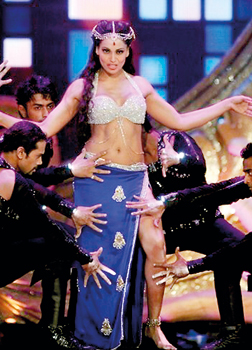Sunday Times 2
Responsibility or censorship: why Bollywood should pick
View(s):By Nivedita Bhattacharjee
NEW DELHI (Reuters)- The mother and father of the 23-year-old Delhi gang-rape victim were cremating their daughter’s body around the same time I discovered Honey Singh, now lately known for his notorious song, “Ch**t,” or “Cu*t.” The song revolves around the singer’s vision of satisfying a woman’s lust, followed by beating her with a shoe and then moving on to other things.

Bollywood star Bipasha basu performs a dance routine (AFP)
While India convulses over its people’s shameful treatment of women, its inadequate rape laws and questions about how to change an entire society, Singh’s star has been rising in Bollywood. The industry apparently likes what it hears.
Whether the trouble he has encountered over his songs will stall that career remains to be seen, but it is safe to say that Bollywood has a record of promoting a dim, if adulatory view of women. But it is time the industry takes responsibility for what it perpetrates under the garb of “entertainment.”
India’s influence over what we see, the tunes we hum and the weaving of the tapestry of our pop culture is huge. Teenagers and adults often dress like the hottest actors and actresses of the season, talk like them and woo each other with songs and dialogue from hit films and almost inevitably have, at some points of their life, imitated their onscreen role models. Bollywood’s bounty is as boundless as the seas, but much of the time, we’re the fish.
When popular actors and producers such Akshay Kumar and Saif Ali Khan become patrons of the likes of Honey Singh, there is little doubt that his popularity will grow. That means that what he thinks and says is OK, or as we might say in Hindi, “OK chalta hain.”
But it’s not OK, telling a woman how you’re going to assault her and then hit her with a shoe. While we would love to live in a world in which adults knew what is right and wrong, we don’t, and that is why we make rules.
Artistic freedom is a fine concept, and liberal as one would want to be, I don’t know what loss the world will suffer when “Pallu ke neeche dabaa ke rakha hai / utha doon toh hangama ho” (“Pressed down underneath my ‘pallu,’ they’ll cause a ruckus if they come out”) is not played on buses and in the nation’s living rooms. Which music lover will miss a song called “Aja teri ch**t maroon”? (“Come let me f**k you”)
Bollywood should and must portray reality, including the dismal treatment of women. But surely portraying reality or realistic situations is different from inviting your audience to leer and demean with you? When Shahrukh Khan gropes his heroine on screen and makes borderline racist jokes (I’m talking about “Ra 1“), I wonder how it champions any cause, let alone that of artistic freedom. No woman I know appreciates being groped or pinched by strangers.
There is a difference between crass and comical. No matter how much we talk about “to each his own”, when SRK does that on screen, my 12-year-old cousin and my parents’ 20-year-old driver think it is acceptable.
Censorship is not bad; neither are rules. It is a matter of how and where we use them. It is a matter of questioning why a movie that shows a mother of two kids being raped by village goons while the father stands helpless is not rated “A” (adults only), and why nobody minds seeing that broadcast on prime time national television.
Bollywood has come a long way from the days of “Pati parmeshwar hain” (“Husband is God”), but its influence has not. Note the poster for the movie “Maine pyar kiya” (“I Fell in Love”) from 1989, and then this one from five years later, for Hum Aapke Hain Koun! (“Who Am I to You!”). The depiction of the heroine’s “place” as times change comes across clearly here, and from a production house that is the poster child of all things mushy Bollywood.
So, the industry is a part of the debate. What side it chooses to argue for is another matter.
Follow @timesonlinelk
comments powered by Disqus

















